bigcypresshunter said:
If the extended piece in question was not cut or broken, what do you think the purpose would be for it?(2)

In other words, in your opinion why is it even there?

Okay BigCH I have studied the photo again and I think I can
shed some light on the extended piece labeled by the red
1 in this photo.
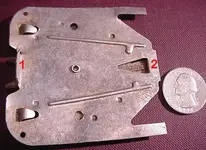
As I said before, I believe this item was mass produced.
It is my opinion that this item was stamped and cut from
long flat aluminum stock that was the width of the item from
top to bottom in the photo. It would be cut to length
at point
1and point
2.
If you flatten the tab at
1 and
match it to point
2 it looks like they would match up in
width. I'm not good enough at photesuite to do this in
a picture, I hope you understand what I am trying to
propose. It may have been bent up the way it is to remove
it from the die or mold that it was stamped into. I don't know.
Does this make any sense?
I don't know why the tab was left on the item but since it was,
it had to be bent over to allow finger access to the points on
the numbered dial. Then again I could be wrong, just speculating.
I also noticed a small scrape or grove between the
3's
that looks like it was
made after the manufacturing process. The interesting thing
to me is that if you follow the line of the scrape it appears to
line up directly with the nick on the bent tab

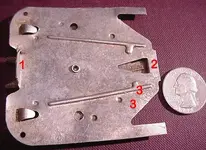



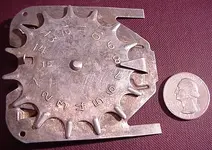
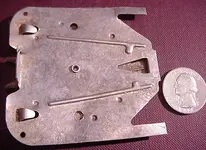
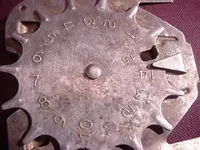

 As much as anyone I want to believe it's a cage mounted egg tallying device - but I'll be danged if I can prove it! And believe me, I'm trying. The thing that's missing here is "solid evidence," and I guess that's what mystifies me most.
As much as anyone I want to believe it's a cage mounted egg tallying device - but I'll be danged if I can prove it! And believe me, I'm trying. The thing that's missing here is "solid evidence," and I guess that's what mystifies me most. 



 Certainly have to give a lot of weight to your input considering your knowledge of the location.
Certainly have to give a lot of weight to your input considering your knowledge of the location.

 I said while I have the item I am willing to take a second(or third) look. The most logical explanation is thermostat but I need a diagram explaining how this item would connect because I dont know.
I said while I have the item I am willing to take a second(or third) look. The most logical explanation is thermostat but I need a diagram explaining how this item would connect because I dont know. 
 In other words, in your opinion why is it even there?
In other words, in your opinion why is it even there? 

